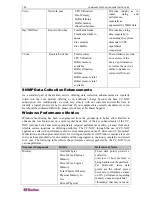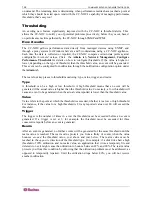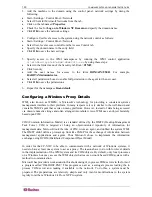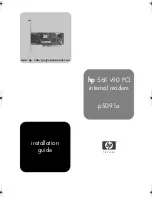
APPENDIX C
:
PERFORMANCE MONITORING
121
Appendix C: Performance Monitoring
Overview
The CC-NOC is designed to provide you with the information necessary to support critical
decisions in your environment. Depending on your role, the nature of those decisions may be
different, from a help desk technician analyzing memory usage on a CC-NOC to determine if
upgrades are appropriate, to a network designer using router buffer failures in support of better
sizing decisions in equipment acquisition.
In Raritan’s quest to provide the right information to the right people with as little administrative
overhead as possible, we have worked with vendors and industry professionals to identify the key
metrics available that best support critical decisions. This document identifies those key metrics,
how the CC-NOC gathers them, and helps to provide an understanding of how they might be used.
SNMP Data Collection
Leveraging SNMP, the CC-NOC has access to a wealth of information on devices of varying
types. This information can vary from network performance information to system component
utilization, for example, CPU, Memory, drives, etc., to very specific metrics that are critical for
very specific reasons.
The CC-NOC, upon discovering that a device supports SNMP, determines whether the device
supports SNMPv1 and/or SNMPv2. SNMPv2 introduced several mechanisms for making data
collection more efficient, and if the device supports it, we will opt for the most effective means of
collecting data. Once done, the device type is determined. This device type indicator allows the
CC-NOC to determine which specific data collections should be put into place for this device. For
example, if the device is a Windows NT server, the CC-NOC recognizes this and gets both
Windows-specific information as well as MIB2 standard information related to network traffic on
the interface. If that server is also running Checkpoint software or the Compaq Insight agent, data
metrics will be harvested from those sources as well.
The chart on the following pages identifies the current set of performance metrics collected and
their importance. Remember, all metrics are additive, so for example, a Windows device that
support RFC1213 will share both Windows-specific metrics, as well as those supported by MIB2.
Note: SNMP data collections require that the managed device supports SNMP and that the CC-
NOC has been configured with the appropriate community string. In many cases, adding SNMP
support is merely a case of device configuration. In other cases, it means that software may need
to be loaded onto the platform. Please consult the documentation for your network equipment
and/or servers for more information on SNMP support.
Summary of Contents for COMMANDCENTER NOC
Page 2: ...This page intentionally left blank...
Page 12: ...xii FIGURES...
Page 20: ...8 COMMANDCENTER NOC ADMINISTRATOR GUIDE...
Page 114: ...102 COMMANDCENTER NOC ADMINISTRATOR GUIDE...
Page 132: ...120 COMMANDCENTER NOC ADMINISTRATOR GUIDE...
Page 144: ...132 COMMANDCENTER NOC ADMINISTRATOR GUIDE...
Page 148: ...136 COMMANDCENTER NOC ADMINISTRATOR GUIDE...
Page 155: ...APPENDIX G NETWORK TRAFFIC OVERHEAD NETWORK MANAGEMENT S NECESSARY EVIL 143 255 80 5301 00...
















































